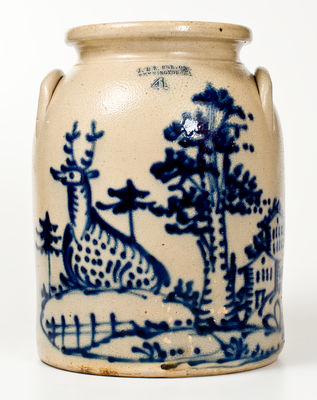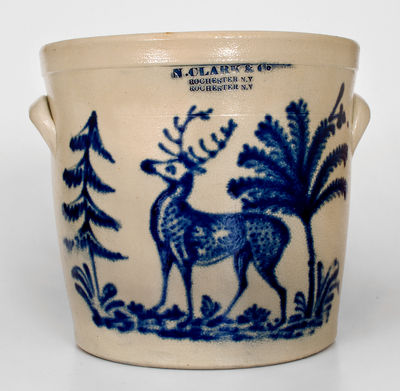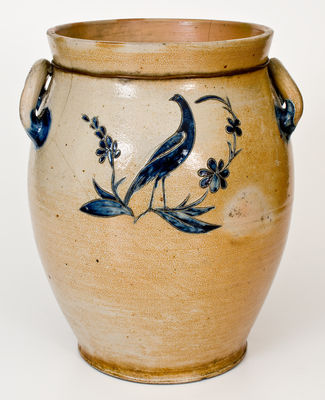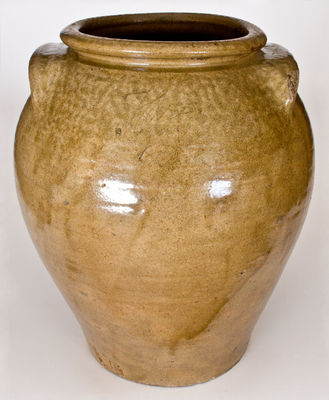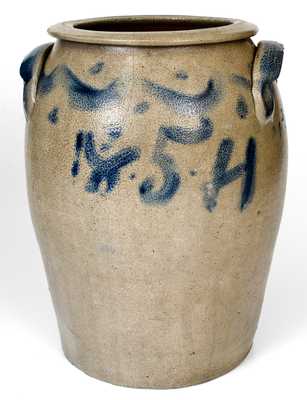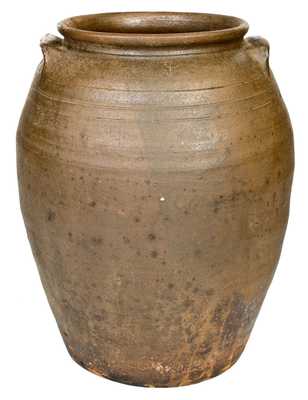Extremely Rare Three-Gallon Alkaline-Glazed Stoneware Jar, Stamped "J.S. NASH," Jefferson S. Nash Pottery, Marion County, TX, circa 1850-1860, ovoid form with semi-rounded rim and deep pocket handles, decorated with an mottled brown, maroon, and gold alkaline glaze. Shoulder impressed with the maker's mark, "J.S. NASH," beside two impressed designs of a cross-within-circle, surrounded by diagonal rays. This jar faithfully follows the Southern stoneware aesthetic of form and glaze, featuring a bulbous body and sophisticated, multi-colored alkaline glaze. Featuring various shades of brown with dark runs at the shoulder and gold mottling throughout, the jar changes color and luster as it is turned. Striking matte-maroon highlights are also visible on various areas of the vessel. According to Amy Kurlander in Texas Clay: 19th-Century Stoneware Pottery from the Bayou Bend Collection, Nash was an entrepreneur and planter born in Georgia in 1804. He arrived in Marion County, TX in 1846, where he established the state's first iron furnace and also a stoneware pottery. He was linked to the Edgefield potting tradition through his brother-in-law, James Gibbs, who was an investor in Edgefield's Pottersville Pottery during the 1840s. Some of the few surviving signed Nash pieces reveal a connection to the Edgefield style, raising the question of who worked at his pottery. (Interestingly, the shoulder of this jar features two impressed circular designs, depicting crosses surrounded by diagonal rays. This cross-within-circle motif is closely-related to a stamped design known as the "Landrum cross," used at the B.F. Landrum Pottery of Edgefield.) Regarding who produced his ware, Nash is often discussed in connection with African-American potter, Milligan Frazier (c.1848-after 1910), who would later operate his own shop near the Nash site. As noted by Kurlander and evidenced in period documents, Frazier, along with his mother and siblings were associates of Nash. However, according to an interview with Frazier's son, the potter had learned the trade while living in Louisiana. Kurlander also notes that both Frazier and Nash were tied to Edgefield-trained potting families in Bienville Parish, LA, further adding intrigue to the story. While Frazier was likely too young to have worked for Nash as a potter, various pieces with glazes similar to that seen on this jar have been attributed to Frazier's hand, either while working under Nash or at his own shop. For the former to be true, Nash's pottery would need to have existed longer than previously thought, which is a possibility. This jar is noteworthy from artistic and historical perspectives, featuring one of the most striking glazes that we have seen on a signed piece of Nash stoneware as well as serving to illustrate the migration of decorative arts styles during Westward expansion. Provenance: Recently discovered in the Midwestern U.S. Excellent, essentially as-made condition with a 5 1/2" vertical firing line at base, which extends 1 1/2" onto underside. H 12 1/2".








